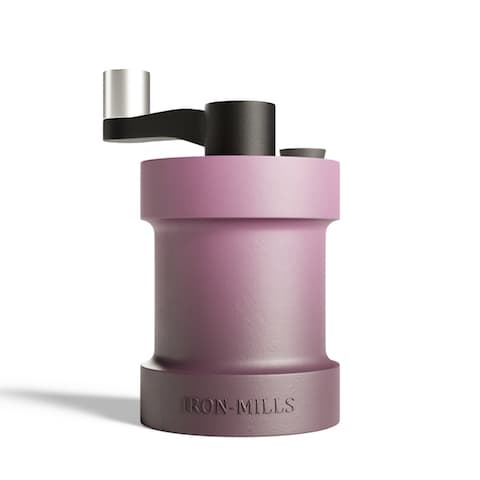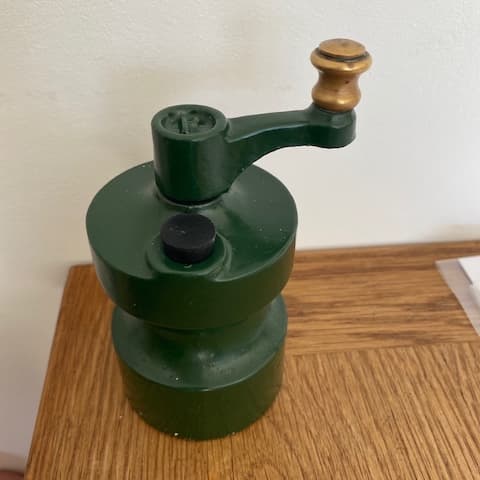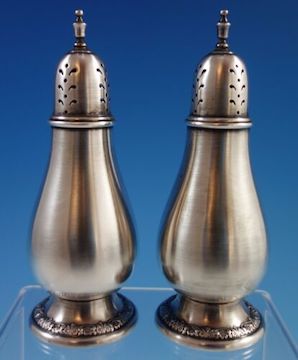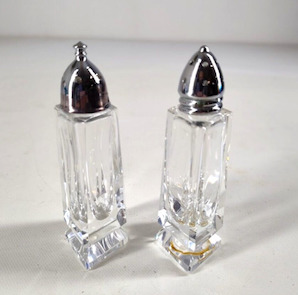
Curated with aloha by
Ted Mooney, P.E. RET

The authoritative public forum
for Metal Finishing 1989-2025

-----
Salt & Pepper Shakers: Sterling or Plated? Refinishing and Restoring
Quickstart (no readers left behind):
Items can be made of solid silver or just have a thin silver plating on them. Solid silver items are usually stamped with "925" or "Sterling", both of which mean 92.5% pure silver.
Q. I have a set of International Silver salt & pepper shakers marked w/crown and 118. Is this plate? Thanks for your help.
Robbin Wright- Trenton, New Jersey
March 30, 2025
A. Hi Robin. There are hundreds if not thousands of different pattern numbers, so a picture would probably help. But a number of folks on eBay have listed their shakers as style 118, with the claim that they are sterling (92.5% solid silver, not plated), so if your set looks exactly like this one, I would be quite confident that it is sterling. Is it marked "Sterling"?
Luck & Regards,

Ted Mooney, P.E. RET
Striving to live Aloha
finishing.com - Pine Beach, New Jersey
⇩ Related postings, oldest first ⇩
Q. I want to remove the rusty caps of old salt and pepper shakers. I don't want to damage them, just get them off!
Larry Thomas- San Diego, California
2001
A. Hi Larry,
Products like WD-40
⇦ this on
eBay
or
Amazon [affil links]
. Liquid Wrench ⇦ this on
eBay or
Amazon [affil links]
, and PB Blaster
⇦ this on
eBay or
Amazon [affil links]
are intended for just this purpose -- have you tried one of them yet?
Luck & Regards,

Ted Mooney, P.E. RET
Striving to live Aloha
finishing.com - Pine Beach, New Jersey
Q. I am looking for a metal or alloy that can be used to make salt & pepper mill. 316 casting, with strong corrosive resistance, is a good method, but it weighs nearly 2000 g. so it is too heavy. Is there any good suggestion?
Don Chan- China
2002
A. I would advise you to use titanium and its alloys which undoubtedly will solve your problems.
Andrey Igolkin- St.Petersburg, Russia
Q. I cannot remove the silver-plated top from a lead crystal salt shaker. Who can Tell me a good method to do so?
Thomasine Breher- San Diego, California, USA
2006
A. Hi. I don't have the problem so I haven't tested it but, considering the fact that metal has a much greater thermal coefficient of expansion than glass, and that any salt crystals can act like miniature ratchets preventing unscrewing, I'd say put it in very hot water for a few minutes to both enlarge the cap and to dissolve any exposed salt, then try to unscrew it while the cap is still at that temperature. Please let us know if it works.

Ted Mooney, P.E.
Striving to live Aloha
finishing.com - Pine Beach, New Jersey
Q. I have received my great-grandmother's salt and pepper shaker set and would like to use them. One of the screw-on tops are flaking off the chrome. Is it possible to have them replated, or is this too small scale?
Beth Miller- Monticello, Minnesota
January 16, 2015
A. Hi Beth. The plating is probably silver rather than chrome, and it's completely possible to replate them, but probably cost prohibitive.
When originally manufactured, hundreds or thousands of caps were plated simultaneously at very low unit labor cost. But for onezy-twozy stuff, plating shops face the same issue that plumbers & car mechanics & everyone else does of high labor costs. If they were able to race it through the shop with a total labor time of 20 minutes, which sounds very optimistic, it could still cost maybe $50. But most shops must do a minimum lot charge, just as appliance service people have minimums, so it could be twice that, maybe even more.
I think you might look on eBay or Etsy and see if you can find something that fits :-)
Regards,

Ted Mooney, P.E.
Striving to live Aloha
finishing.com - Pine Beach, New Jersey
What coating for a new line of cast iron salt & peppers shakers?
Q. Hi all,
I am about to start producing a range of cast iron salt & pepper mills for sale online. The design was inspired from a 1960's Robert Welch pepper mill that I inherited from my grandparents.
I would greatly appreciate any help with selecting a coating that is suitable for direct food contact to coat the inside of the mills and any advice on the application method that would be suitable. Ideally the coating chosen would be certified for use in Europe, America, Australia, Canada and other countries also.
My preferred design the mill body is cast in one piece but I think this will be quite hard to coat the internal void? I have drawn up a second design where there is a removable base plate in the bottom to allow access to the inside (see attached cross section drawings) [please see ed. note]. I would prefer to avoid the second option as this will add machining and assembly operations. I guess it will come down to which costs more.
Any help appreciate - Thanks all!
- Bristol, U.K.
May 8, 2020
Ed. note: We've received no drawings; please attach them in email to mooney@finishing.com
A. I'm apprehensive about cast iron for salt. Salt will adsorb some moisture from the air and will promote corrosion of cast iron. It might be possible to coat the interior with some sort of organic coating, but given the inherent roughness of cast iron, it might never be free from voids.

Jeffrey Holmes, CEF
Spartanburg, South Carolina
|
A. I second Jeffrey's comments. Salt kills cast iron FAST (source: I'm a cast iron fanatic and won't even salt my concoctions until they're out of the pan for risk of pitting).  Rachel Mackintosh lab rat - Greenfield, Vermont A. Hi Guy  Geoff Smith Hampshire, England |
Comment: Hi Jeff, Rachel & Geoff - Thanks for taking the time to comment. Logging back in to comment via my account was not very obvious so I guess I am commenting as a guest [please see ed. note].
Yeah I accept that CI probably isn't the best material for this application. That said, CI gives it the right weight & feel that I am trying to create, so is an excellent fit for the mission of the brand.
I am glad that you referenced Le Creuset, this is what I am aiming for in terms of quality & style. The designs that I have made use a similar colour scheme for the exterior.
**My design was inspired by the Robert Welch Mill, it is not a direct copy and is very different and purely my own**
I have considered making an insert as you suggested. I am leaning in favour of finding a suitable coating as I think the insert will bring it's own unique set of challenges to overcome.
I am surprised to hear that coating the ID will be such a challenge because of the surface finish though. Originally I was planning on having the exterior powder coated and the local shops near me have not raised this as a concern when in discussion about the exterior. Is a powder coat easier to apply to Cast Iron?
I have read online that there are food safe powder coats that can be used - This could be a winning solution as it is cheap to buy/apply. The ID is around 70 mm in my second design so not bad in terms of access.
Price wise - I am looking at the higher end of the market. My vision is to produce something that has an air of quality like old US / UK made war era products, rarely seen anymore. I want it to last & be passed on to grandchildren as mine was...
I know that this may make it niche but that is usually a good place to start when building a brand, as defining the customer will be easier and the purpose.


Haha yes I think I will coat both the S&P versions inside to be safe. I will have to use a disclaimer label & warning video to tell customers not to put salt in the pepper mill as the grinding mechanisms I am using vary in price dramatically for each!
Rachel - I will look into GE F50TF3 and report back if it is something that I can use.
If you think of any other info I will be very interested to hear.
Thanks for your time,
Guy
- Bristol, England, UK
Ed. note: Sorry for the misunderstanding, Guy: there are no accounts, usernames or passwords to log back into :-)
The site is open to all, maintaining the original dream of the worldwide web, that the people of the world would be able to "surf the net"; but yes we are becoming unusual as nearly all of the world's websites now require registration, precluding such surfing. :-)
A. If you can mask off the outside of the part than you can plate with highP electroless nickel. The inside of the part should be machined to a very low Ra to get the best corrosion protection. EN is also allowed for food contact. I would recommend 1-2 mils (25-50 µm).

George Shahin
Atotech - Rock Hill, South Carolina
Q, A, or Comment on THIS thread -or- Start a NEW Thread

